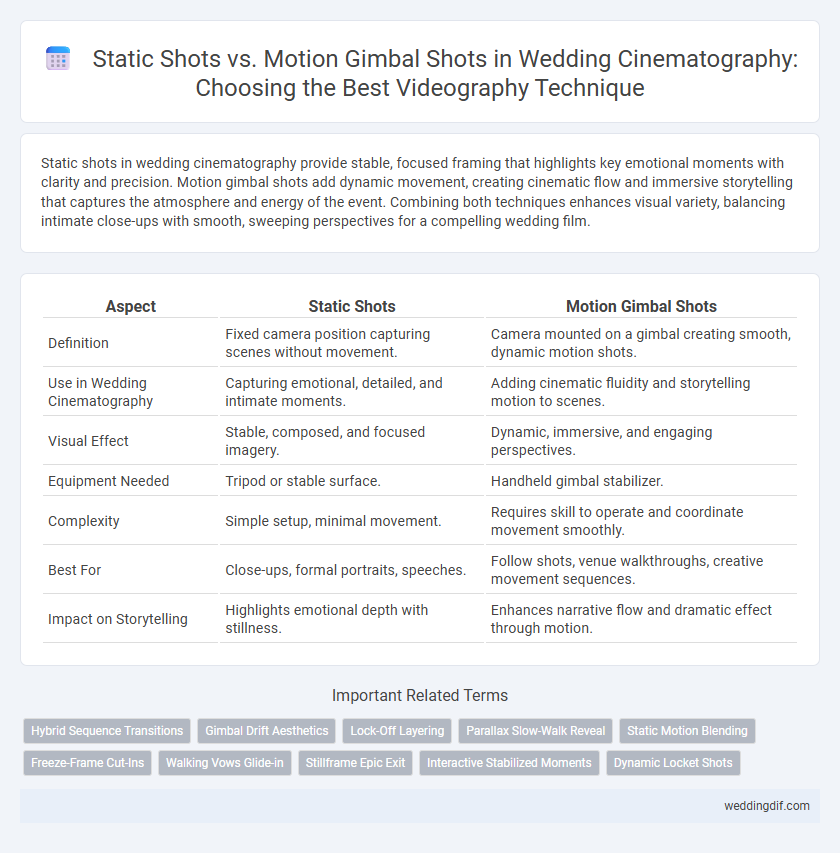Static shots in wedding cinematography provide stable, focused framing that highlights key emotional moments with clarity and precision. Motion gimbal shots add dynamic movement, creating cinematic flow and immersive storytelling that captures the atmosphere and energy of the event. Combining both techniques enhances visual variety, balancing intimate close-ups with smooth, sweeping perspectives for a compelling wedding film.
Table of Comparison
| Aspect | Static Shots | Motion Gimbal Shots |
|---|---|---|
| Definition | Fixed camera position capturing scenes without movement. | Camera mounted on a gimbal creating smooth, dynamic motion shots. |
| Use in Wedding Cinematography | Capturing emotional, detailed, and intimate moments. | Adding cinematic fluidity and storytelling motion to scenes. |
| Visual Effect | Stable, composed, and focused imagery. | Dynamic, immersive, and engaging perspectives. |
| Equipment Needed | Tripod or stable surface. | Handheld gimbal stabilizer. |
| Complexity | Simple setup, minimal movement. | Requires skill to operate and coordinate movement smoothly. |
| Best For | Close-ups, formal portraits, speeches. | Follow shots, venue walkthroughs, creative movement sequences. |
| Impact on Storytelling | Highlights emotional depth with stillness. | Enhances narrative flow and dramatic effect through motion. |
Introduction: The Art of Wedding Cinematography
Static shots capture timeless, composed moments with clarity and precision, making them ideal for highlighting intricate details and emotional expressions during a wedding. Motion gimbal shots add dynamic fluidity and cinematic movement, enhancing storytelling by seamlessly following the bride and groom's journey with steady, graceful sweeps. Combining both techniques elevates wedding cinematography, blending grounded elegance with immersive visual narratives.
Defining Static Shots in Wedding Videography
Static shots in wedding videography involve positioning the camera on a stable surface or tripod, ensuring a steady and unchanging frame that captures significant moments with precision and clarity. These shots emphasize composition, lighting, and emotion without movement, allowing the viewer to focus on the subject's expressions and details such as the bride and groom's attire or the ceremony backdrop. Static shots are essential for highlighting formal aspects of the wedding, creating a timeless and elegant visual narrative.
Exploring Motion Gimbal Shots
Motion gimbal shots elevate wedding cinematography by providing smooth, stabilized footage that captures dynamic movement with cinematic flair. These shots enhance storytelling by creating immersive perspectives, such as tracking the bridal procession or gracefully orbiting the couple during vows. Utilizing a three-axis gimbal, videographers achieve fluid transitions and professional-quality captures that static shots cannot replicate.
Visual Impact: Comparing Static vs Motion Shots
Static shots in wedding cinematography offer crisp, detailed framing that emphasizes emotional expressions and intricate details, creating a timeless and elegant visual impact. Motion gimbal shots introduce fluid movement and dynamic perspectives, enhancing storytelling by capturing the event's energy with smooth transitions and immersive angles. Balancing static precision with gimbal motion ensures a captivating visual narrative that highlights both intimate moments and lively celebrations.
Storytelling Through Static Frames
Static shots in wedding cinematography emphasize storytelling by capturing detailed, emotionally rich moments with intentional framing and composition, allowing viewers to absorb the scene's depth and atmosphere. These shots highlight facial expressions, intricate details, and subtle interactions, creating a timeless narrative that motion gimbal shots might overlook due to constant movement. Utilizing static frames enhances the cinematic quality by fostering a deeper emotional connection and emphasizing the significance of key wedding moments.
Enhancing Emotion with Gimbal Movement
Static shots in wedding cinematography provide stability and a timeless feel, capturing intimate moments with clarity and focus. Motion gimbal shots enhance emotion by adding fluid movement that immerses viewers in the scene, creating a dynamic and romantic atmosphere. The smooth, controlled glide of a gimbal introduces a cinematic quality, allowing subtle shifts in perspective that highlight the bride and groom's connection and the ambiance of the celebration.
Practical Considerations: Equipment and Setup
Static shots in wedding cinematography require minimal equipment, often just a tripod and a stable camera, making the setup quick and straightforward. Motion gimbal shots demand specialized stabilizers and practice to operate smoothly, providing dynamic footage but increasing setup complexity and time. Choosing between the two depends on the balance between desired visual effect and available setup resources during the wedding shoot.
Editing Workflow Differences
Static shots in wedding cinematography simplify the editing workflow by providing consistent framing and stable footage, reducing the need for extensive stabilization and frame adjustments. Motion gimbal shots introduce dynamic movement, requiring editors to balance smooth transitions and color grading to maintain visual continuity while correcting for any residual shake or motion blur. Efficient editing of gimbal footage often demands advanced software tools and meticulous attention to motion tracking and keyframing to achieve cinematic storytelling.
Choosing the Right Technique for Each Wedding Moment
Static shots capture intimate wedding moments with stability and clarity, emphasizing emotion and detail through careful framing. Motion gimbal shots introduce smooth, dynamic movement, enhancing storytelling by following the action or revealing the venue's ambiance. Selecting between static and gimbal techniques depends on the moment's emotional intensity and desired cinematic effect, ensuring each scene is visually compelling and immersive.
Final Thoughts: Balancing Static and Motion Shots
Balancing static shots and motion gimbal shots in wedding cinematography creates a dynamic visual narrative that captures both intimate details and sweeping moments. Static shots provide stability and focus on emotional expressions, while motion gimbal shots introduce smooth movement and cinematic flair. Combining these techniques enhances storytelling by blending clarity with fluidity, delivering a compelling and immersive wedding film experience.
Static Shots vs Motion Gimbal Shots for wedding cinematography. Infographic

 weddingdif.com
weddingdif.com